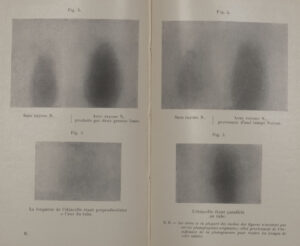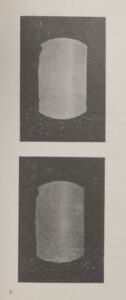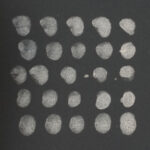In science, the appearance of success can be illusory, and what seems to be a startling achievement may end in embarrassment. Such is the sad case of the N-ray, a particle “discovered” in 1903 by René Blondlot, a distinguished French physicist. Blondlot (1849-1930) published this book as well as 23 separate articles on his exciting discovery. At the time, X-rays were still a fairly recent phenomenon, having been detected and named by Wilhelm Röntgen in 1895 — an achievement that earned Röntgen the first Nobel Prize in Physics in 1901. There was glory in the discovery of new rays, and Blondlot was determined to find some.
But what were N-rays? Blondlot argued that they were a new type of electromagnetic radiation. Among the alleged sources of N-rays were X-ray tubes, heated sheet iron, and the sun. N-rays could be detected by using a flame of gas from a small orifice, in conjunction with a ground-glass plate to observe the reflection, and with surfaces covered with a calcium sulfide deposit film. Blondlot also claimed that N-rays could be stored in materials such as traversed platinum. Another French scientist, Augustin Charpentier, thought that N-rays were emitted from the human body, even after death. Numerous researchers began writing about N-rays, and nearly 300 articles were published on the topic by 1906.
 Some scientists were unconvinced by Blondlot’s arguments, however, and many could not detect the rays when duplicating his experiments. In 1904, the same year this book was published, the American scientist (and one-time MIT researcher) Robert W. Wood (1868-1955) traveled to Blondlot’s lab in France to see for himself the truth of Blondlot’s claims. During one trial, Wood took a necessary piece of the experimental equipment and put it in his pocket, without Blondlot’s knowledge, in order to debunk Blondlot’s findings. Even without the prism that was crucial to the experiment, Blondlot still claimed to have observed N-rays. With that, he was in effect exposing his own folly. Wood published his findings in the September 1904 issue of Nature, discrediting Blondlot and ending science’s affair with the N-ray.
Some scientists were unconvinced by Blondlot’s arguments, however, and many could not detect the rays when duplicating his experiments. In 1904, the same year this book was published, the American scientist (and one-time MIT researcher) Robert W. Wood (1868-1955) traveled to Blondlot’s lab in France to see for himself the truth of Blondlot’s claims. During one trial, Wood took a necessary piece of the experimental equipment and put it in his pocket, without Blondlot’s knowledge, in order to debunk Blondlot’s findings. Even without the prism that was crucial to the experiment, Blondlot still claimed to have observed N-rays. With that, he was in effect exposing his own folly. Wood published his findings in the September 1904 issue of Nature, discrediting Blondlot and ending science’s affair with the N-ray.
Blondlot had used photographic evidence to support his claims. As shown in these images, he tried to demonstrate that photographs of light sources exposed to N-rays would produce a darker negative than those not exposed to N-rays. Later detractors found evidence that differences among the photographs were caused by inconsistencies in photographic emulsions, exposure time, and development of the film.
Blondlot’s story provides an object lesson in the need for scrupulous control of variables when conducting scientific experiments. Moral: don’t let N-rays happen to you.


